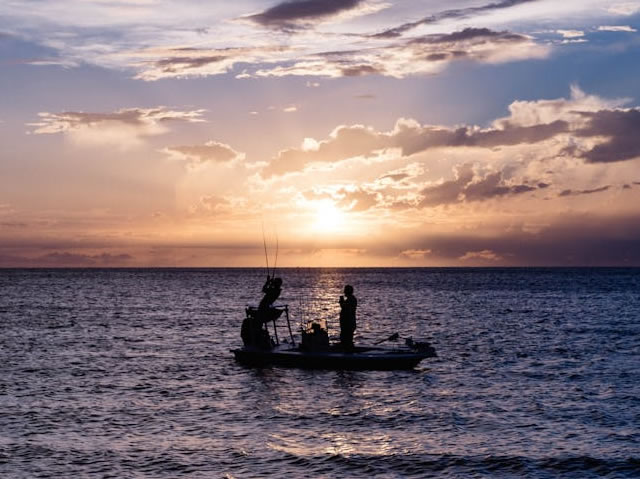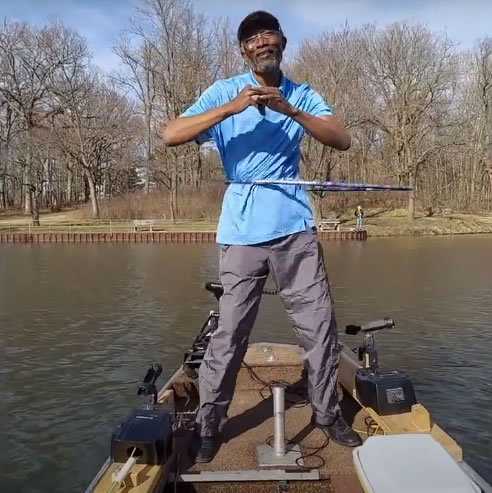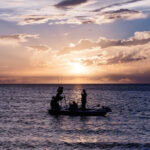In Jesse’s own words…
Best spot fishing makes a substantial difference. Story 6
Location is another crucial factor. Points, coves, and areas with abundant cover such as fallen trees, rocks, and vegetation are prime spots to find bass. Observing the water for signs of activity, such as splashes or jumping fish, can also guide you to the best fishing spots. Patience and persistence are key, as the early morning bite can sometimes be fleeting. However, with the right preparation and a bit of luck, bank fishing for bass at dawn can provide a fulfilling and memorable experience.
Using two rod and reel setups while fishing can offer several significant advantages, enhancing both the efficiency and enjoyment of the activity. Firstly, leveraging two rods allows anglers to cover more water and increase their chances of catching fish. By casting in different areas or at varying depths, anglers can experiment with multiple techniques and bait types simultaneously. This approach can be particularly valuable in unfamiliar waters, where identifying the most productive spots and effective lures quickly can make a significant difference.
Photo Credit: FisherMap.org
Using Jesse’s own words, we came up with this for content for the website article.
Fishing for bass in the early morning hours is more than just a peaceful way to start the day—it’s a prime time for anglers to connect with nature and land a big catch. As the sun rises and the world wakes up, the conditions are perfect for bass to be on the hunt, making it an ideal time for bank fishing.
Why Early Morning is the Best Time for Bank Fishing
Early morning is considered the golden hour for bass fishing, particularly from the bank. Here’s why:
-
Cooler Water Temperatures: During the early hours of the day, the water temperature is cooler, which bass prefer, especially in the warmer months. Cooler temperatures encourage bass to move closer to the shore to feed, increasing your chances of a successful catch.
-
Increased Bass Activity: Bass are most active during the early morning when they are hunting for food. They often move into shallower waters to ambush prey, making them more accessible to bank anglers.
-
Low-Light Advantage: The low-light conditions of dawn make it easier to sneak up on bass without startling them. Bass have excellent vision in low light, giving them an edge over their prey—and you, an edge over them.
Essential Gear for Early Morning Bass Fishing
Success in early morning bass fishing starts with the right gear. Here are some essentials to consider:
-
Topwater Lures: During low-light conditions, topwater lures such as poppers, frogs, and buzzbaits are particularly effective. These lures create surface disturbance that mimics the movement of prey, enticing bass to strike. The excitement of a bass breaking the surface to hit a topwater lure is unmatched and is a big draw for many anglers.
-
Soft Plastics: Soft plastic worms, craws, and lizards are versatile and can be fished in various ways to target bass in different situations. Texas-rigged worms or weightless Senkos are great for fishing near vegetation or around submerged structures. The subtle movement of these baits often triggers strikes from bass that are less active or hiding in cover.
-
Jigs: Jigs are a staple for bass anglers and can be incredibly effective when fishing near structures such as rocks, docks, or submerged trees. Their versatility allows you to fish them slowly along the bottom or with a hopping action to mimic crayfish or other prey. Pairing a jig with a soft plastic trailer adds to its appeal, making it irresistible to bass.
-
Rod and Reel Combo: A medium to medium-heavy rod with a fast action tip is ideal for bass fishing. It provides the sensitivity needed to detect light bites while offering enough backbone to set the hook firmly. Pair this with a spinning or baitcasting reel that has a smooth drag system, allowing you to handle the powerful runs of a big bass.
Techniques to Increase Your Chances of Success
Knowing how to use your gear effectively is key to maximizing your chances of catching bass from the bank. Here are some techniques to try:
-
Vary Your Retrieve: The way you retrieve your lure can make a big difference in enticing a bite. Start with a slow and steady retrieve, then switch to a faster pace or add pauses to create a more erratic action. Experimenting with different speeds and techniques can help you determine what the bass are responding to on any given day.
-
Focus on Structure: Bass are ambush predators and often hide near structures where they can easily surprise their prey. Look for areas with submerged rocks, fallen trees, weed beds, or docks. Casting your lure parallel to the bank or right along the edge of these structures can increase your chances of drawing a strike.
-
Pay Attention to the Water: Keep an eye on the water for signs of bass activity, such as jumping fish or ripples on the surface. This can indicate the presence of baitfish and, consequently, bass. Casting into these areas can lead to quick strikes.
-
Stay Stealthy: Move slowly and quietly along the bank to avoid spooking fish. The less disturbance you create, the more likely you are to catch fish that are close to the shore. Wear natural-colored clothing that blends in with the surroundings, and keep your profile low to avoid being seen by the fish.
Adapting to Changing Conditions
The conditions on the water can change rapidly, and successful anglers know how to adapt. Here are some tips for adjusting your strategy:
-
Adjust for Weather Changes: If the weather changes—such as a sudden increase in wind or cloud cover—bass behavior can change too. Wind can push baitfish into certain areas, so casting with the wind can help you find more active fish.
-
Match the Hatch: Pay attention to the type of prey present in the area you’re fishing. If there are a lot of frogs or insects on the surface, topwater lures might be the most effective. If baitfish are abundant, consider using lures that mimic their size and color.
-
Change Depths: If you’re not having any luck in the shallows, try deeper water close to the bank. Bass may move deeper as the sun gets higher or if the water temperature rises quickly. Switching to a lure that can reach deeper water can make all the difference.
Enjoying the Experience
While the goal is to catch bass, remember that the experience of being outdoors, surrounded by nature’s beauty, is equally rewarding. Whether you land a big one or not, the early morning tranquility and the thrill of anticipation are what make bank fishing for bass such a beloved pastime.
So, grab your gear, head to your favorite fishing spot, and enjoy the peaceful, productive hours of early morning bass fishing. With the right preparation and a willingness to adapt, you’re sure to have a memorable and successful outing.







